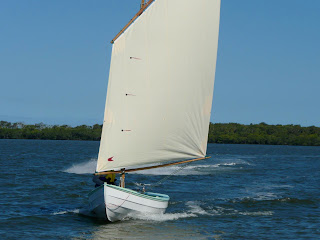Rossco,
While you are on hull forms & bottoms,you might like to comment on what sailing qualities to expect from a double-ender like the little 12' Peapod by Arch Davis featured in the current WB magazine.A pretty boat & a style which I just know has exercised your enquiring mind & generated a sketch or three of your own ideas.
Your experience with your Iain Oughtred sailing canoe would be a big help I trust,being of similar length but much narrower beam.
btw,I'm posting as anonymous as my Google a/c keeps deleting my message when I try to send & tells me it is an "Input error" which my investigations have found is happening with anyone using Google a/c in IE9.
Al Burke
 |
| I don't have any photos of the Oughtred Macgregor under sail, but here is a picture which gives an idea of the hull shape |
Unfortunately, I have very little experience sailing larger double-ended boats, so I can't answer Al's question with any authority. However, I'm very interested in the hullform for several reasons: -
- A double-ended hull tends to have similar amounts of reserve buoyancy forward and aft of the centre-of-buoyancy and centre-of-floatation. In very simple terms, this means that you avoid the problem of a broad-sterned boat having the stern lifted by a wave and having the less-buoyant bow sections pressed underwater. In another example, you can have the situation where a broad-sterned boat is pushing into a short head-sea and the reserve buoyancy of the stern prevents the bow from lifting to the on-coming waves. In the same situation, a double-ender is much more likely to lift her bow as the similar-sized stern is depressed.
- When a sailing boat which has broad, relatively flat aft sections heels, the turn-of-bilge is forced down into the water, and as a result, the entire aft part of the boat is lifted by the buoyant stern and the bow is forced downwards. This is a situation which is frequently seen occurring on modern ocean racing yachts - the wide, flat sections aft allow these boats to achieve very high speeds when the sheets are eased, but the boat must be sailed as flat as possible. On the other hand, a double-ender is much more likely to retain proper fore-and-aft trim when heeled at substantial angles.
- When a small boat is heavily loaded, or is trimmed down by the stern, the transom is often immersed, causing excess drag and wild eddies. If double-ended, an overloaded or poorly trimmed boat will avoid much of the eddying and associated drag.
- Lastly, a double-ended dinghy can be pulled up a beach bow-first without having a wide, flat transom bashed constantly by breaking waves and powerboat wakes.
 |
| Here you can see the same boat being sailed flat by her owner, John Shrapnel. It is a different point-of-sail, but note the way the bow has lifted . |
So, given that my sailing experience with double-enders is limited, here is my opinion. I think that the balance and seakindliness of the double-ender, allied with the load flexibility, make the form better suited to rowing dinghies than sailing dinghies. However, there is a place for a nicely shaped double-ender as a rowing boat with auxilliary sail. I don't have the knowledge to speak about larger boats with ballast keels.
 |
| A 15 ft x 4.5ft boat I modelled for my own use. |
 |
| Another view of the same model. Note how I have used very firm bilges to try to retain sail-carrying power |


Hi Ross,
ReplyDeleteI'm very interested in the idea of beach cruising open boats like the Phoenix III. Have the adjustable sleeping platform benches shown in your photo gallery been trialled yet, or do most australian beach cruisers set up in a tent on shore? How would you set up the Phoenix III for a sleep-on-board cruise? A Mike Rowe style story might be useful...?
Thanks, Jack